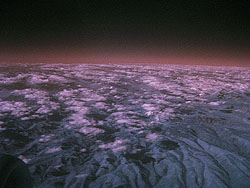
Click to enlarge
Simply putting a double layer of fully-exposed color negative over a Canon A540 revealed it does have some decent near-IR leakage. Exposures were deliberately underexposed at 1/3 second to prevent image shake. I used some auto-leveling in Photoshop and faded it back a little.
You can see a number of interesting details in the image.
The first is the darkness of the sky above the horizon. Anyone from the old photography days with a red filter and black and white film is familiar with this effect. The blue sky is caused from Rayleigh scattering of photons by the molecules of air, and it's dependent on the inverse fourth power of the wavelength of light. So, blue photons of 450nm scatter 16 times more intensely than near-infrared light of 900nm. Right at the horizon the only scattering is visible in the red channel, which from previous posts we know is the nearest of the near-IR (i.e., just past 750nm). In the green there is no scattering---just a solid ball of earth with no haze. Like a planet with no atmosphere.
Expanding further on the RGB channels: the red is clearly a tail effect of the red filter--so we know the output is or around 700-750nm. It may have an additional output somewhere higher up if the coloring fades away in the IR. The blue should have a passband around 900nm, given that most bandpass filters will also pass double their wavelength (450nm being blue). Green would, if the doubling held, pass 1000nm, i.e. 1 micron, but at that point most CCDs made of silicon begin to really drop out and to get decent response you'd need an optically thick chip (as light absorption varies in depth in silicon in proportion to photon energy. See the Foveon chips for a practical use of this). And this seems to match the intensity of each channel: Red and Blue dominate, making a raw image very purple out of the camera. Green is always the weakest channel. It may either be passing generic IR from a weak filter or from the color negative filter.
I assume the clouds and the snow-covered peaks (right-center) reflect all wavelengths equally. Assuming that, the ground appears to reflect the lower-wavelength (i.e. deeper into the IR) IR better than the near-IR wavelengths.
The ground itself has some real variations in IR reflectivity, although it's difficult to see clearly: far-right center shows a redder response on a slope. I'd love to correlate some near-IR curves to some common mineral types. I do need to calibrate the wavelength response of the cameras. This isn't the image to do it with and I have some better ones with simultaneous visible light images.
P.S. The curvature of the horizon is just from the camera lens, not the real curvature of the earth.
2 comments:
Very cool post. And the important thing is that you apparently did not get hassled by the flight crew or Homeland Security for doing something unusual with a camera!
Thanks! One of things I had planned on doing I can't now: Southwest now doesn't allow a GPS to be used in flight. It would have been very useful to correlate the cosmic ray readings with location because I think I see a variation due to geomagnetic latitude. http://dwarmstr.blogspot.com/2005/02/geiger-counter.html
There's no interference generated on a GPS, so I can only imagine security theater is the reason.
They used to allow it; I sat next to a frequent flier who used one after talking with the pilot.
Post a Comment